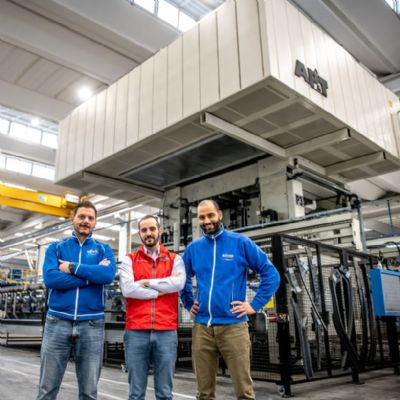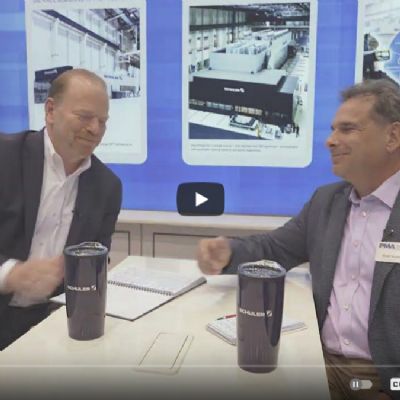Meet the Press
|
Making the Clad Master Blanks Deep-Draw Capable 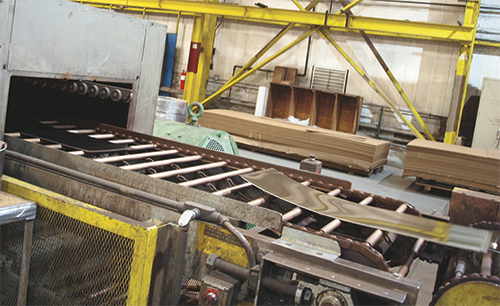
To build up its clad packs of master blanks, All-Clad brings in coils slit to the various widths needed to match the required blank sizes, which run on cut-to-length lines to produce the required strip lengths. Strips as large as 48 in. long by 22 in. wide are then layered and processed on a two-stage rolling mill into clad master blanks, referred to as “packs” at All-Clad. For a three-ply blank, Type 304 stainless steel comprises the inside cooking surface and a magnetic stainless-steel grade comprises the outer layer. Sandwiched in between is a layer of aluminum. Five-ply packs include two additional layers of aluminum and a second layer of magnetic stainless. Each pack yields two to four deep-draw blanks. Since the move to deep drawing the clad blanks, DeHosse and his cohorts have spent considerable time and resources optimizing the cladding process to improve bond strength. “The window of bond strength has narrowed with deep drawing in the hydraulic presses,” DeHosse says. “The challenge has been to improve process repeatability in our cladding furnaces, in part by installing new temperature-monitoring equipment. Overheating the packs causes excessive grain growth in the aluminum, which impacts forming characteristics in the press and can cause an orange-peel texture on the inside of the pan.” Even as overall scrap rate since the move to hydraulic presses is far below that of hydroforming, “and the blank-size reduction makes the move to deep drawing a no-brainer,” DeHosse says, the quality-control efforts made in the cladding operation have yielded marked and measurable improvements. “For example,” shares DeHosse, “one of our big scrap items historically has been the 8-qt. stock pot, 10.5-in. dia. with a 6.5-in. draw. Scrap rate had been as high as 8 to 10 percent, but on the last run, after making the process modifications in the cladding department, scrap rate scored less than 0.5 percent on a 3000-piece run.” |
At the new Greenerd hydraulic press, we watched DeHosse form 7-qt. stock pots; a 7.75-in. draw reduces a 17.75-in.-dia. blank to an 8.4-in. dia. pot. “We do everything in a single draw,” notes DeHosse, “with a stationary form ring in the upper ram, the punch mounted stationary in the press bed and a floating cushion.”
Press specs: 36-in. left to right and front to back; adjustable force from 112 to 562 tons; adjustable stroke to 40 in.; ram speed to 912 in./min. on close and 95 in./min. during forming; cushion force adjustable from 28 to 280 tons, with a 16-in. stroke; 20-ton ejection force; and ram-mounted knockout force to 30 tons.
Rather than design the press with an integral blankholder, each tool features its own blankholder. And while DeHosse says that the drawing process would function similarly whether the blankholder was mounted to the press or tool, there is one distinct advantage to having it in the tool.
“With the blankholder on the tool,” he says, “we can set a very low blank-holding force, since we’re using purely hydraulic valving to control the force, independent of the weight of the ram. If we hold these blanks too tightly, we’ll experience stress cracks and fractures at the top of the draw. By reducing blankholding force, we promote better material flow throughout the drawing operation.”
Die work—new builds and maintenance—is performed by a local shop, AccuDie Inc., Meadow Lands, PA. “AccuDie functions as our external toolroom,” says DeHosse. “Our projects take priority; they’re in here three to four times per week picking up and dropping off. Of particular concern are the draw rings (of Ampco bronze); they see a lot of heat and oxidation from the stainless steel. That oxide buildup has to be removed and the rings polished every 2000 to 3000 draws.”
Ram-stroke settings are controlled by digital linear transducers, “and the end-of-draw repeatability with the Greenerd press has been spectacular,” shares DeHosse, noting that “we don’t draw to positive stops, we draw to ram position. With our other two hydraulic presses, we experience significant drift during drawing. With the new press, if we need to reduce draw depth by 0.030 in. we adjust the program and rest easy knowing the accuracy and repeatability will be there.”
Also included with the press: a bar-code reader that operators use to scan the dies and call up the appropriate forming recipe; and light curtains across the front of the press with mirrors along the back to reflect the curtain and completely guard the press perimeter.
|
Triple-Action Press Technology— Submitted by Thomas M. Lavoie, applications engineering manager, Greenerd Press & Machine Co., Inc.; www.greenerd.com Triple-action hydraulic presses feature several cylinders that can perform multiple operations during one setup, often the case when forming cookware as well as aerospace components and other products. The three actions include the main punch, cushion and blankholder platen. The presses can help to eliminate additional tooling requirements while enabling manufacturers to produce more uniform components, rather than having to manipulate the part several times with different tools. A triple-action press also provides complete control over the various ram movements. The ability to set and manipulate parameters will result in the most efficient cycle possible, for a better-finished part. Parameters can include draw speed, reverse tonnage on the cushion, and when to actuate an eject function. Depending on the application, the press can be custom-designed to meet specific requirements. Consider the examples below. 1) For some applications, including cookware, a triple-action press includes a main slide (where the tooling is mounted), a knockout/eject mounted on or above the main slide and a cushion/eject mounted below the press bed. This design proves useful for drawing a deep pan—the part draws over a punch but sticks in the upper tool when the main slide retracts. At that point, the knockout/eject can keep the part down on the punch or strip the part from the upper tool. Here, the cushion/eject is used primarily to provide pressure on the material so it can be drawn without wrinkling or tearing. By altering the press design and mounting the punch to the main slide, the cushion/eject will provide blankholding force during the downstroke of the main slide. The cushion/eject then would be used to push the part up and off of the lower tool or punch. 2) For other applications, a triple-action press includes a blankholder slide—which allows a higher-tonnage ram to run through the middle of the press—as well as a bed-mounted cushion/eject. The press can feature any combination of cylinders to provide power to form, punch, coin, draw, etc. in one setup, and finds use in the manufacture of jet-engine cowlings. The main slide serves as a blankholder platen, and applies adjustable tonnage to the material as the main ram (located in the middle of the main slide) descends to form the cowling. The cushion/eject can be used to push the part up and out of the lower tooling. 3) A triple-action press also can allow for a reverse draw to, for example, produce a “wave” form on the bottom of the part. In this case the main punch descends as the blankholder clinches the material. When the main ram reaches its full depth, it holds its position while the pressurized cushion/eject cylinder pushes back against the main ram. This action produces a small form or “wave” on the bottom of the drawn part. Here, the cushion is used on the downstroke to help draw the part and reverts to an eject to produce the form. |
Consistent Lubricant Application
Before the blanks feel the pressure, they’re run through a Unist SPR-2000 Sproller lubricant applicator, which applies a controlled layer of heavy-duty chlorinated draw lube (Prodraw 150, from Wallover Oil Co.) top and bottom.
“We added the Unist systems in mid-2012,” says DeHosse, “to remove operator inconsistency from when applying lube manually. We experience more forming problems from too much lube, rather than not enough, because excess lube can get trapped between the blank and the blankholder. This can cause radial lube lines to form in the upper lip of the pan. We’ve completely eliminated that problem with the new lube systems.”
After deep drawing, parts travel by conveyor (part of the one-piece flow setup installed in 2010) to a hydraulic trim press, then on to CNC lathes for edge finishing. They then route to a washing system (supplied by Walsh Manufacturing), which in 2010 replaced three separate wash lines— “One more step in the process to implement single-piece flow,” shares DeHosse.
“We’ve decreased the time it takes to move blanks from the blanking cell to a final buffing operation,” continue DeHosse, “from 4 to 5 days when we were batch processing to as little as one shift.” MFView Glossary of Metalforming Terms
See also: Greenerd Press & Machine Co., Unist, Inc., FANUC America, Inc., Aida-America Corp.
Technologies: Stamping Presses







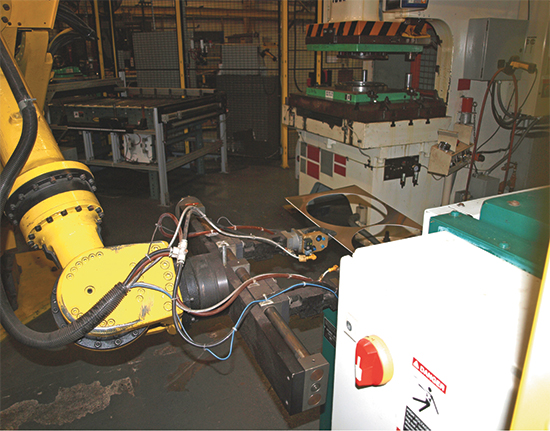
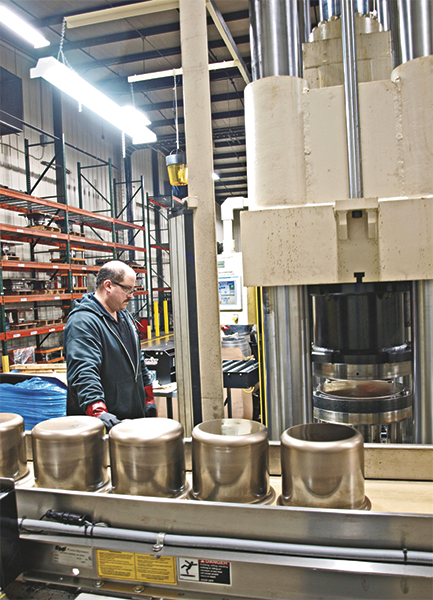
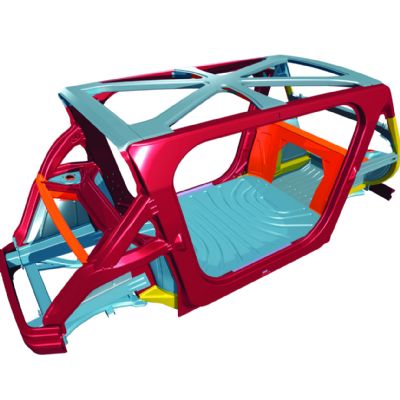
 Video
Video